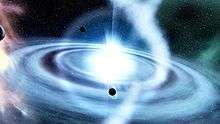ZX Spectrum demos
| Demoscene |
|---|
 |
| Concepts |
| Alternative demo platforms |
| Current parties |
| Past parties |
| Websites |
| Magazines |
| Software |
|
ZX Spectrum demos are demos made for the ZX Spectrum and compatible computers.[1][2][3][4][5][6][7] [8][9] The demo scene on the Spectrum can probably be traced back to Castor Cracking Group, The Lords[10] and a few other groups and individuals back in 1986. The ZX Spectrum demo scene was slow to start,[11] but it started to rise in the late 1980s, most noticeably in Eastern Europe[6][12][13] and southern Europe.[14] Some demos were also released with magazines on cover tapes.[15]
Hardware
Although there are many demos made for the 48K Spectrums,[16] most current Spectrum demos require the additional features found in the Spectrum 128K, that is, 128 KiB of RAM and the AY-3-8912 sound chip. Also, many demos have been designed to run from a floppy disk rather than a cassette tape.
In many eastern European countries, the various Spectrum clones used to be more common than the original models, a fact that also reflects in the choices of hardware among the demoscene. For example, on most Russian demoscene events, the standard "compo Spectrum" is the Pentagon 128 with a floppy disk drive. Since there are considerable technical differences between the Pentagon and the original Spectrum, particularly in the video timing, there are also many demos that require a Pentagon to run properly.
Status
In the former Soviet Union and Eastern/Central Europe, the ZX Spectrum often has a cult status similar to the Commodore 64 in the Western Europe: it was the most popular 8-bit homecomputer and also the first computer for many computer and demoscene enthusiasts. Therefore, whereas many major Western European demo parties organize demo, music and graphics competitions for the Commodore 64, the parties in the east often have the corresponding ZX Spectrum competitions instead.
Design
The earliest demos were simple music players with music ripped from games and perhaps simple effects or text scrollers. Many scrolltext may contain rude words.[17] Many later demos feature so-called 'multicolor' effects (changing the color attributes of the ZX Spectrum's display configuration of 768 character blocks), which have to be fixed to a specific ZX Spectrum model. Megademos, demos with more content, usually split into several parts, appeared in the beginning of 90's, with the advent of the The Lyra II by ESI. Most of the demos since 1996 have been "trackmos" (effects fixed to music), often featuring 3D objects, sometimes in low resolutions, to achieve more colours.
Demoparties
ZX Spectrum demos have been shown at multi-platform demoparties such as Assembly, and there used to be various Spectrum-only parties, such as Funtop in Moscow. The largest party today that regularly features the ZX Spectrum is Chaos Constructions in Saint Petersburg. Outside of Russia there is the famous Forever demoparty.
References
- ↑ TechRadar: 10 of the coolest demoscene creations
- ↑ Vice: Demoscene - The Art of the Algorithms Looks At The History Of A Digital Subculture
- ↑ Collins, Karen. From Pac-Man to Pop Music: Interactive Audio in Games and New Media.
- ↑ Impagliazzo, John. History of Nordic Computing 2. p. 291.
- ↑ Zone, Ray. 3DIY: 3D Moviemaking on an Indy Budget. p. 69.
- 1 2 Woodcock, Colin. The ZX Spectrum on Your PC. p. 28.
- ↑ Hacking Europe. p. 146.
- ↑ Michael, Flenov. Hackish C++ Games & Demos. p. 9.
- ↑ The Video Game Industry: Formation, Present State, and Future. pp. 139–140.
- ↑ Your Sinclair: Quinquagesima
- ↑ Advanced ZAT Programming, issue 25, 1994: Demo&Co
- ↑ Your Sinclair: Megademo
- ↑ Demoscene – The Art of the Algorithms (2012)
- ↑ Hemdatornytt nr 2 1990, p 70
- ↑ World of Spectrum - Sinclair Infoseek
- ↑ Demotopia
- ↑ Your Sinclair: Shock
External links
- ZX Spectrum demos at DMOZ
- Demotopia
- ZX Spectrum demoscene news
- ZX Spectrum Demo&Gift Base (3700 Demos, 455 Gift's!)
- Forever 8bit demoparty